Today's class was super successful! I am so happy with how it went!
Every student divided into about five groups, each consisting of five or six people. If one is working with another student on the project, they had to separate into different clusters. The main goal of these gatherings was to explain our own projects and converse with everyone on either on ideas or improvements. Once a student gave her explanation, the listeners are to give his or her opinion and suggestions on how to make it better. The fact that every partner was separated made it better because then each individual can receive even more feedback rather than just from four people.
As I was listening to others explain their magazines or film opening ideas, I made sure to express all of my constructive criticism in order to aid their projects and hoping they would do the same for me.
When it was my turn to describe my film opening aspects, I began the discussion by showed the multiple students in my group the "Love, Simon" clip that I have previously added to this blog last week. I thought that by showing the opening scene of this film would show my vision rather than me trying to explain each characteristic as some may not be able to envision my explanation.
Indeed, that worked! They understood my film opening vision, which is a "teen flick," and agreed that this genre and execution was a unique idea that they thought could be completed successfully.
In their opinion, Adobe Pro is a more efficient editing software than iMovie is, which is a platform I have been using for a long time. It offers a free trial for a week which is more than enough time for my partner and I to develop our film opening. If I end up liking its' features, I will purchase for future editing.
They informed me that this editing application is trouble-free with the sound techniques, which is an aspect I do not have much experience in. Adobe Pro allows users to includes dials that lets editors eliminate background noise, a feature I need if we end up filming a part of our film opening in school.
Also since I am doing this film opening project with a partner, this editing software allows more than one individual to work on the video. This aids us in making our project more efficient and allows us to communicate easier.
I am super excited that the group discussion was successful since I learned something I have never heard of! I definitely will be looking further within this editing software.








